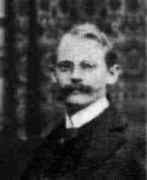Person: Bernstein, Felix

Felix Bernstein established his famous theorem on the equivalence of sets while in Cantor's seminar at Halle in 1897. He also worked on transfinite ordinal numbers.
Mathematical Profile (Excerpt):
- Felix Bernstein was brought up in Halle, attending the gymnasium there.
- In 1896 Cantor took a holiday and Felix Bernstein offered to correct the proofs of Cantor's famous work Beiträge zur Begründung der transfiniten Mengenlehre Ⓣ(Contributions to the creation of transfinite set theory).
- It was at this time that he came up with the Schröder-Bernstein Theorem which we discuss below.
- Bernstein had, as that stage, no intention of becoming a mathematician and he went to Pisa where he studied philosophy, archaeology and art history.
- Two mathematicians who had heard Cantor heap praise on Bernstein for the Schröder-Bernstein Theorem, persuaded the student of fine arts at Pisa to become a mathematician.
- Felix submitted his habilitation to the University of Göttingen and he was appointed extraordinary professor there in 1911.
- The war ended in 1918 but Bernstein continued to hold government roles becoming Commissioner of Finance in 1921.
- In 1928 Bernstein spent time at Harvard in the United States as a visiting professor.
- The exemptions should have meant that Bernstein was unaffected but, like almost all Jewish academics, he was deprived of his chair in 1934.
- Since he moved around between universities, Bernstein's scientific output was, as one might expect, greatly reduced after 1934.
- By 1948 Bernstein was 70 years old and he retired from teaching in the United States returning to Göttingen where he was appointed professor emeritus.
- Today Bernstein is best remembered by mathematicians for the Schröder-Bernstein Theorem.
- When Cantor saw Bernstein's proof he was so impressed that he communicated it to Émile Borel and it was published in Borel's Lecons sur la théorie des fonctions in 1898.
- We mentioned above that the result is known as the Schröder-Bernstein Theorem.
- The theorem was stated by Cantor in Beiträge zur Begründung der transfiniten Mengenlehre Ⓣ(Contributions to the creation of transfinite set theory) but his justification of the result there is not a rigorous proof (as he himself was aware) and, as we explained above, it was while correcting the proofs of this work that Bernstein, still a high school student, constructed a correct proof.
- In 1905 Bernstein published another important article on transfinite ordinal numbers Über die Reihe der Transfiniten Ordnungszahlen Ⓣ(On the series of transfinite ordinal numbers) which appeared in Mathematische Annalen.
- Despite this highly significant result in the foundations of pure mathematics, most of Bernstein's activity was in applied mathematics, particularly in statistics, actuarial mathematics and mathematical biology.
- It would certainly be fair to say that, outside the world of mathematics, Bernstein is best known for his work on human blood groups and inheritance so we should end this biography by looking briefly at these important contributions.
Born 24 February 1878, Halle, Germany. Died 3 December 1956, Zürich, Switzerland.
View full biography at MacTutor
Tags relevant for this person:
Origin Germany, Set Theory
Thank you to the contributors under CC BY-SA 4.0! 

- Github:
-

- non-Github:
- @J-J-O'Connor
- @E-F-Robertson
References
Adapted from other CC BY-SA 4.0 Sources:
- O’Connor, John J; Robertson, Edmund F: MacTutor History of Mathematics Archive
